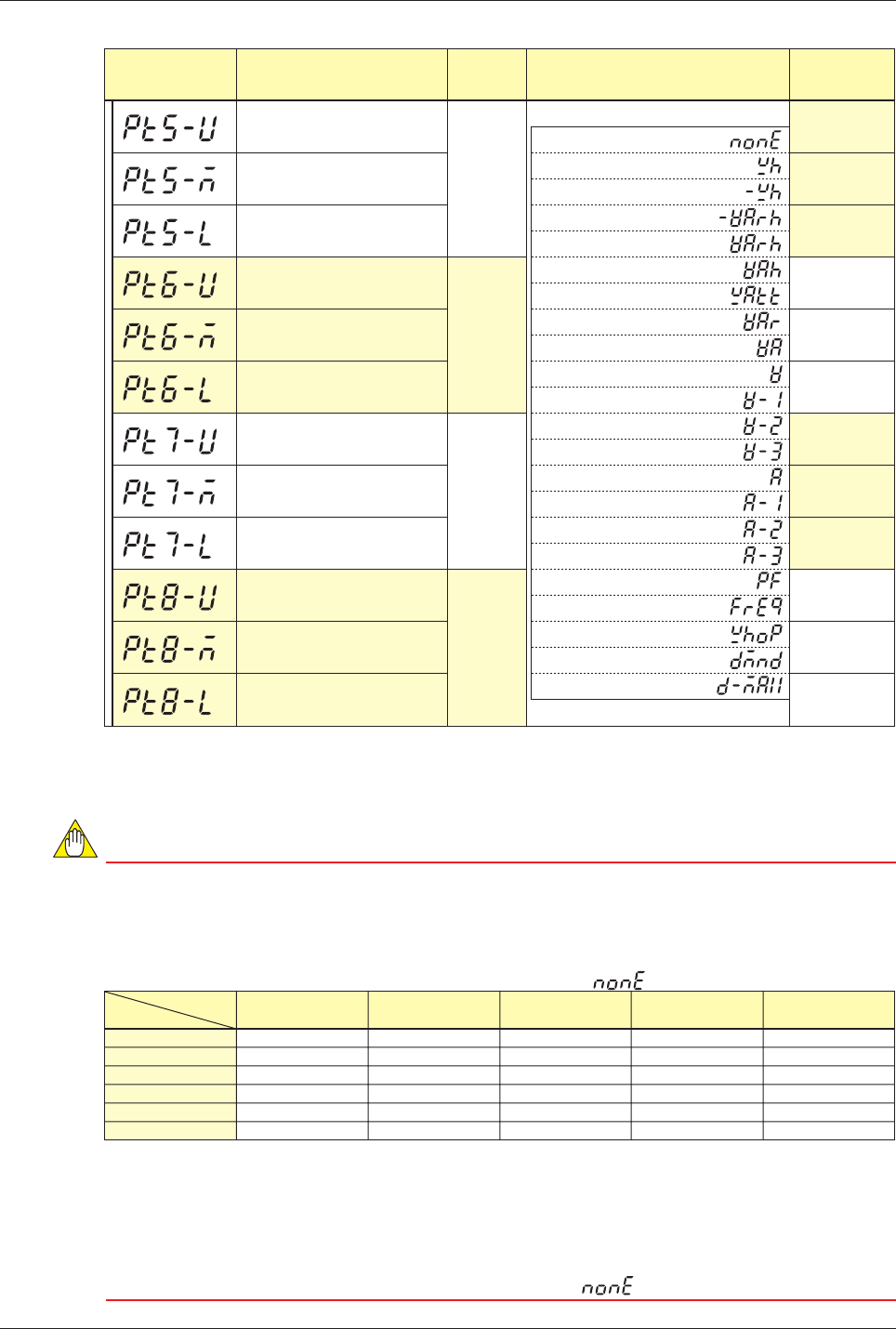Energy Meter Manual
Table Of Contents
- Introduction
- Notices
- Checking the Package
- Checking the Model and Suffix Codes
- Contents
- Chapter 1 Installation and Wiring
- 1.1 Installation with the ANSI 4-inch Round Form or JIS 110-square Instrument Size
- 1.2 Installation with the DIN 96-square Instrument Size
- 1.3 Wiring
- Crimping Terminal Recommendations
- Single-phase two-wire system (voltage input, current input, power supply)
- Single-phase three-wire system (voltage input, current input, power supply)
- Three-phase three-wire system (voltage input, current input, power supply)
- Three-phase four-wire system (voltage input, current input, power supply)
- Three-phase four-wire system (2.5 element) (voltage input, current input, power supply)
- Other Wiring
- 1.4 Attaching the Dust Cover and Terminal Cover
- Chapter 2 Preparations before Starting Measurement (Set up the PR300 First)
- Chapter 3 Parameter Setting Operations
- 3.1 Basic Parameter Setting Operations
- 3.2 Setting the VT and CT Ratios
- 3.3 Setting the Integrated Low-cut Power
- 3.4 Setting RS-485 Communication Conditions
- 3.5 Setting Ethernet Communication Conditions
- 3.6 Setting Pulse Output Conditions
- 3.7 Setting Analog Output Conditions
- 3.8 Setting Demand Measurement Conditions
- 3.9 Setting the Measured Value Display Pattern
- 3.10 Setting the “Indicator-out” Mode and Locking Parameters
- Chapter 4 Operation for Display of Measurement Items and Measurement Method
- 4.1 Measurement Items
- 4.2 Switching Display Pattern
- 4.3 Displaying Measured, Instantaneous, and Maximum/Minimum Values
- Example Display and Measuring Ranges of Active Power (Regenerative Power)
- Example Display and Measuring Ranges of Reactive Power
- Example Display and Measuring Ranges of Apparent Power
- Example Display and Measuring Ranges of Voltage
- Example Display and Measuring Ranges of Current
- Example Display and Measuring Ranges of Power Factor
- Example Display and Measuring Ranges of Frequency
- How to Switch between Instantaneous Value, Maximum Value, and Minimum Value
- 4.4 Phase Switching for Voltage and Current
- 4.5 Displaying Energy Values
- 4.6 Resetting Measured Values
- 4.7 Demand Measurement (Optional Measuring Function)
- Chapter 5 Troubleshooting
- Appendix
- Appendix 1 Specifications of PR300
- Measuring Function
- Power Items and Equations
- Input Specifications
- Digital Input Specifications
- Analog Output Specifications (additional output function)
- Pulse Output Specifications (additional output function)
- Demand Alarm Output Specifications (optional measuring function)
- Communication Specifications
- Standard Performance
- Safety and EMC Standards
- Environmental Conditions
- Mounting and Shape
- Appendix 2 System Reset
- Appendix 3 Parameter Map
- Appendix 4 Parameter List
- Appendix 5 Alphanumeric Characters Table for 7-segment LED
- Appendix 1 Specifications of PR300
- Index
- A
- C
- D
- E
- H
- I
- M
- O
- P
- R
- S
- T
- V
- W
- Wiring diagram
- Single-phase two-wire system
- Single-phase three-wire system
- Three-phase three-wire system
- Three-phase four-wire system
- Three-phase four-wire system (2.5 element)
- Analog output
- Demand alarm output
- Demand alarm release
- Ethernet communication
- Integration control signal
- Palse output
- RS-485 communication
- Wiring diagram

3-18
IM 77C01E01-01E
3.9 Setting the Measured Value Display Pattern
Parameter Setting Types and Ranges (Continued)
Voltage-2
Voltage-3
Current
(phase switch
inidication)
Voltage
(phase switch
inidication)
Frequency
Current
(phase switch
inidication)
Active power
Power factor
Active power
Maximum
demand value
Demand value
Display pattern-5 upper display
Display pattern-5 middle display
Display pattern-5 lower display
Display pattern-6 upper display
Display pattern-6 middle display
Display pattern-6 lower display
Display pattern-7 upper display
Display pattern-7 middle display
Display pattern-7 lower display
Display pattern-8 upper display
Display pattern-8 middle display
Display pattern-8 lower display
Selection
Selection
Selection
Selection
A measurement item can be selected from the
following:
None
Active energy
Regenerative energy
LEAD reactive energy
LAG reactive energy
Apparent energy
Active power
Reactive power
Apparent power
Voltage (phase switch inidication)
Voltage-1
Voltage-2
Voltage-3
Current (phase switch inidication)
Current-1
Current-2
Current-3
Power factor
Frequency
Optional active energy
Demand value
Maximum demand value
Voltage-1
Parameter Symbol Parameter Name
Setting
Type
Setting Range (Details)
Initial Value
(Factory-set
Value)
Number of Display Patterns and Individual Display Patterns
Allocate desired measurement items to the upper, middle and lower displays of the PR300, respectively, to define
the display view as a single display pattern. It is possible to define a maximum of 8 patterns. For the number of
display patterns, specify how many of these defined display patterns the PR300 should show.
NOTE
● As shown in the table below, some measurement items cannot be measured depending on the type
of phase and wire system. Measurement items that cannot be measured cannot be selected as
options for a display pattern.
● In the case of a three-phase four-wire system, the initial values of Display patterns-1 to 8 can all be
shown on the PR300. For phase and wire systems other than a three-phase four-wire system,
measurement items that cannot be measured are shown as “
”.
Current
Current-1
Current-2
Current-3
Voltage-2
Voltage-3
Single-phase
two-wire system
–
✔
–
–
–
–
Single-phase
three-wire system
✔
✔
✔
–
✔
–
Three-phase
three-wire system
✔
✔
–
✔
–
✔
Three-phase
four-wire system
✔
✔
✔
✔
✔
✔
Three-phase four-wire
system (2.5 element)
✔
✔
–
✔
–
✔
✔: Measurable. –: Not measurable.
*1
*1
*1
(phase switch
inidication)
Measurement item
Phase and wire
system
*1 For a three-phase four-wire system (2.5 element), it is possible to set the following measurement items
only when the current is in a state of equilibrium:
Current (phase switch indication), Current-1, Current-3, Reactive power, Apparent power, Power factor,
LEAD reactive energy, LAG reactive energy, and Apparent energy.
● The demand value and maximum demand value can only be selected for a PR300 with the demand
measuring function. For a PR300 without the demand measuring function, the initial values of
demand value and maximum demand value are shown as “ ”.










